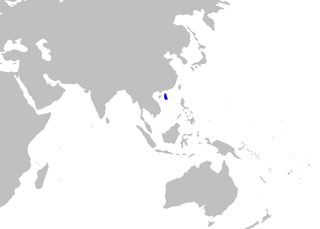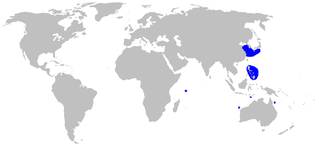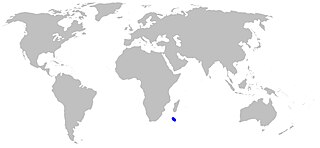
Scyliorhinidae is a family of sharks, one of a few families whose members share the common name catsharks, belonging to the order Carcharhiniformes, the ground sharks. Although they are generally known as catsharks, some species can also be called dogfish due to previous naming. However, a dogfish may generally be distinguished from a catshark as catsharks lay eggs while dogfish have live young. Like most bottom feeders, catsharks feed on benthic invertebrates and smaller fish. They are not harmful to humans. The family is paraphyletic, containing several distinct lineages that do not form a monophyletic group.
Kazuhiro Nakaya is a Japanese marine scientist and ichthyologist. He graduated from Hokkaido University with a BA in 1968 and with a PhD in 1972. He is professor of Marine Environment and Resources at the Marine Laboratory for Biodiversity. He specializes in taxonomy and evolution of sharks, rays, chimaeras, and Lake Tanganyikan fish. He is the author of many articles and books on sharks and fish. In 1995 he was put in charge of dissecting and preparing the 7th specimen of the very rare megamouth shark.

Parmaturus is a genus of deepwater catsharks in the family Pentanchidae. Four species were described in 2007 and another in 2019 with more species likely to be described in the near future.

Galeus is a genus of deepwater catshark, belonging to the family Pentanchidae, commonly known as sawtail catsharks in reference to a distinctive saw-toothed crest of enlarged dermal denticles, found along the upper edges of their caudal fins. They are found in the Atlantic, the western and central Pacific, and the Gulf of California, inhabiting deep waters at or close to the sea floor. Members of this genus are rather small, slim sharks with firm bodies and thick, rough skin. Their heads are usually fairly long and pointed, and have large mouths with well-developed furrows at the corners. They have large pectoral and anal fins, and two similar dorsal fins placed well back. Many species are ornately patterned with dark saddles and/or blotches. Sawtail catsharks feed on various invertebrates and fishes, and may be either egg-laying or live-bearing. These harmless sharks are sometimes caught as bycatch but are of minimal commercial value.

The humpback cat shark is a shark of the family Pentanchidae, the deepwater catsharks, in the order Carcharhiniformes, found in the northwest Pacific Ocean off Zhujiang, South China Sea, from the surface to 915 m. Its length is 39–41 cm. The largest specimen examined by Nakaya and Sato was 54.2 cm TL. The humpback catshark is a little-known oviparous deepwater catshark.

The shortnose demon catshark is a shark of the family Pentanchidae, the deepwater catsharks. This species is found only in deep water in the East China Sea. Its length is up to 40 cm. A. internatus is known only from the holotype and a paratype, both caught in the East China Sea, probably taken as bycatch in deepwater trawl fisheries. The reproduction of this catshark is oviparous.

The Panama ghost catshark is a species of shark belonging to the family Pentanchidae, the deepwater catsharks. This little known catshark is only found off Panama, between 9°N and 2°N. The reproduction of the Panama ghost shark is oviparous.

The Saldanha catshark is a species of shark belonging to the family Pentanchidae, the deepwater catsharks. This catshark is found from Cape Columbine to south of False Bay in South Africa, between 31 and 40°S. Its length is up to 88 cm (35 in). It is a plain, dark grey-brown, stout catshark, with moderately large eyes, a broad snout, and large pectoral fins.

The smalldorsal cat shark is a species of shark beloning to the family Pentanchidae, the deepwater catsharks. This shark is found in the South China Sea, at depths to 915 m. It can grow up to 37 cm. A. micropterygeus is unique among its species in having a narrow and sharply pointed first dorsal fin. However, Nakaya and Sato (2000) recommended that the status of the species be reviewed once additional specimens are available, citing the possibility that the dorsal fin of the holotype may have been malformed. The reproduction of the smalldorsal catshark is oviparous.

The longhead catshark or smoothbelly catshark is a species of shark, family Pentanchidae, the deepwater catsharks. This shark has a patchy distribution in the Indo-Pacific from Mozambique to southern Japan to northern Australia. It is found in water between 500 and 1,140 m deep. This species grows to 59 cm (23 in) long and is characterized by its extremely long and narrow snout, short abdomen, and long anal and caudal fins. In addition, a large area of the anterior ventral portion of its body lacks dermal denticles. The longhead catshark is oviparous and the only known cartilaginous fish that is normally hermaphroditic, with the majority of individuals having both the functional reproductive organs of one sex and the undeveloped reproductive organs of the opposite sex.
The roughskin catshark is a species of catshark in the family Pentanchidae, the deepwater catsharks. This species is found near Australia and New Zealand. Its natural habitat is the open seas. This species belongs to a genus of poorly known deep-water catsharks.
Bythaelurus is a genus of sharks belonging to the family Pentanchidae, the deepwater catsharks. The genus Bythaelurus Compagno 1988 was first described as a subgenus of Halaelurus Gill 1862 based on several morphological characteristics including a soft body with thin skin, a bluntly rounded snout without a pointed, knob-like tip, and eyes not noticeably elevated on the dorsal surface of the head. Members of this genus are generally found in deep water and have more somber body coloration.
The jaguar catshark, also known as the Galápagos catshark, is a species of shark belonging to the family Pentanchidae, the deepwater catsharks, endemic to the Galápagos Islands. The species was first described in 2012. This catshark is about 30 cm (12 in) long when mature, and it is colored blackish-brown with an asymmetrical pattern of light spots.
The milk-eye catshark (Apristurus nakayai) is a species of shark in the family Scyliorhinidae found in Coriolis Bank off western New Caledonia. Its natural habitat is the open seas. The new deep-water catshark, Apristurus nakayai, is described from northern New Caledonian waters.
Garrick's catshark is a species of shark in the family Pentanchidae, the deepwater catsharks. This species is found in the waters of New Zealand. Its natural habitat is the open seas. The new deep-water catshark, Apristurus garricki, is described from the waters of northern New Zealand. It is named in honour of Jack Garrick.
The shortbelly catshark is a shark of the family Pentanchidae, the deepwater catsharks. It is found in the Gulf of Aden, Indian Ocean. This species most closely resembles the western Atlantic species Apristurus canutus, but is distinguishable in having greater nostril length than internarial width and longer claspers in adult males.

Apristurus manocheriani, Manocherian's catshark, is a species of shark belonging to the family Pentanchidae, the deepwater catsharks. This species was originally described by Justin A. Cordova and David A. Ebert in 2021.

Bythaelurus bachi, commonly known as Bach's catshark, is a species of shark belonging to the family Pentanchidae, the deepwater catsharks. This shark is found on the southern Madagascar Ridge in the southwestern Indian Ocean. This stout-bodied catshark is thought to inhabit the deep sea at depths of 910–1,365 m (2,986–4,478 ft).











